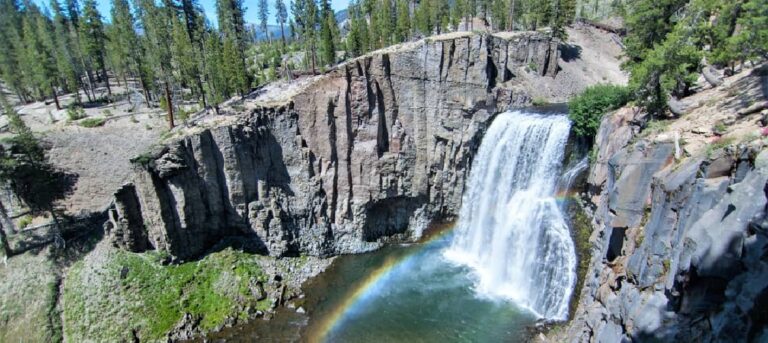
An RV drive along Highway 395 will take you past numerous fascinating (and sometimes just plain odd-looking!) geological formations, plus sparkling lakes, snow-capped mountains, and Wild West panoramas.
I always describe Highway 395 as following the spine of California – for the most part, it follows the eastern state line. 395 continues on through Oregon and Washington, but the most famous (and, in my opinion, the most interesting) sights to see are in California. The drive starts (or ends, depending on which way you go) in Hesperia, about an hour and a half east of Los Angeles. The other end of the 1,300-mile drive is at the Canadian border.
This trip will take you from the Oregon state line to San Bernardino, near Hesperia. You’ll take short detours to check out three national parks, the largest alpine lake in North America, a ghost town, the tallest mountain in the continental U.S., and numerous lakes and other sites of interest.
Some detours on this route take you over mountain passes that are only open during summer. However, you’ll also hit one of the hottest places on earth…so the best time of year for you to travel will depend on what you want to see most.
Ready? Let’s hit the road!
Lassen Volcanic National Park
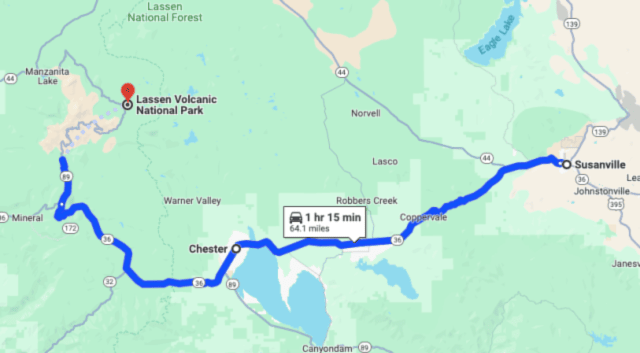
We’ll begin at the northern end of the drive, with a stop at Lassen Volcanic National Park. You’ll need to detour off the highway near Johnstonville, head through Susanville, and take Highway 36 through Chester to the park. It’s worth the detour to explore Lassen! It’s hard to reconcile the strange, eerie appearances of the geothermal features with the amazing alpine views and crystal lakes – but you’ll get both here. Visit hydrothermal areas with bubbling mudpots and steaming vents. Then visit Lake Helen, a beautiful mountain lake with amazing views of Lassen Peak. You could easily spend several days to a week exploring and camping at Lassen.
Recommended RV campground: Mt. Lassen / Shingletown KOA Holiday, although there are several excellent campgrounds near Lassen Volcanic National Park.
Lake Tahoe
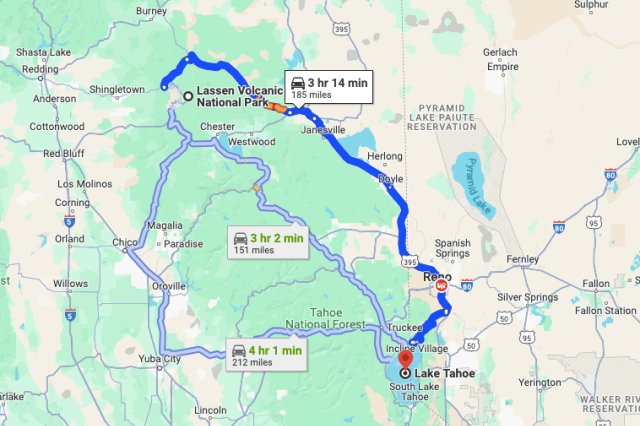
From Lassen Volcanic National Park, head back to 395. You could make time for a stop in Chester to enjoy Lake Almanor and the small-town feel of the area. Once on 395, you’ll head south through Reno to Carson City before taking Highway 50 to Lake Tahoe. It wouldn’t be hard to spend a week in the Tahoe area, enjoying the lake, doing some hiking, and hitting the casinos. South Lake Tahoe has the most options for food, activities, and campgrounds, although you’ll need to reserve a site well in advance!
Recommended RV campground: Camp Richardson Resort, although you’ll find many Lake Tahoe campgrounds in the area.
Bodie Ghost Town
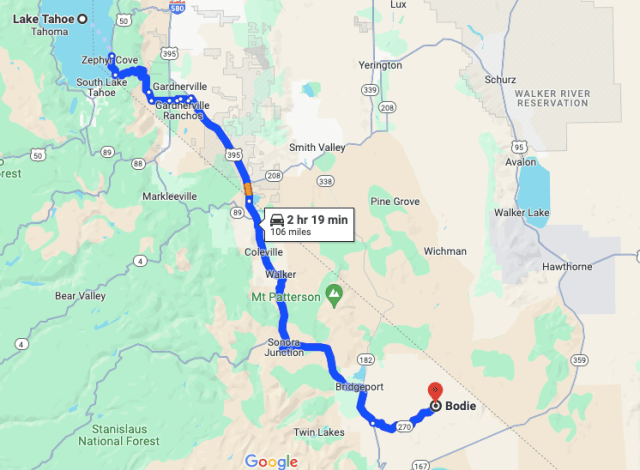
Bodie State Historic Park is home to a ghost town from California’s mining days. In its heyday, Bodie had about 2,000 structures and 8,000 people. Bodie has been preserved as it was when the last of its residents left, which means there are still goods on shelves and you can see buildings as they were. There is a museum bookstore, but there are no commercial services like gas or food. Also, the road into Bodie can be hard to navigate in an RV, depending on the weather. You may want to leave your RV at the campground and drive a tow vehicle to the park. Or consider camping at Mono Lake, where there are lots of services, and making the hour drive from there to Bodie for the day.
Recommended RV campground: Bridgeport Reservoir Marina and Campground
Mono Lake
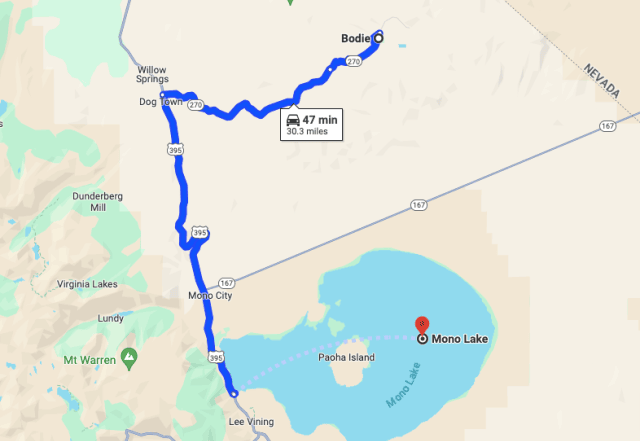
Mono Lake is about an hour from Bodie and you could make that your home base to explore both the ghost town and the lake area. Take time to explore the Mono Lake Tufa State National Reserve to see the whimsical tufa towers in the ancient lake. These strange formations were made as freshwater springs interacted with the alkaline lake water. You can swim, kayak, and hike around the area.
Recommended RV campground: Mono Vista RV Park
Yosemite National Park
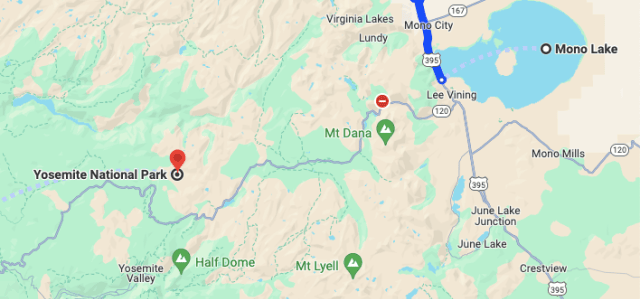
If you’re driving 395 in summer, you can take Tioga Pass from the Mono Lake area into Yosemite National Park. You’ll see iconic landmarks like Half Dome, Yosemite Falls, and El Capitan. You could definitely spend a week in Yosemite, but you can see a lot in just two or three days as well.
Tioga Pass is a steep, winding mountain pass, so consider that as you plan your RV trip. There is no guaranteed date when it opens each spring, so you’ll need to check the Tioga Road Opening updates. If you want to visit Yosemite from 395 while the pass is closed, you can take a much longer detour from 395 to Highway 108. The Tioga Pass drive is about 90 minutes to two hours without stops, while the longer detour is four hours.
Recommended RV campground: Tuolumne Meadows Campground
June Lake
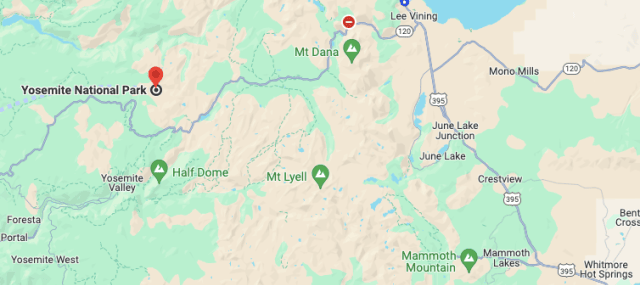
After coming back over Tioga Pass from Yosemite, you can make an easy day of driving by stopping at June Lake just south of the Mono Lake area. There are actually several lakes near June Lake, and the 12-mile June Lake Loop drive is a scenic way to see them. You can fish, hike, swim, and kayak.
Recommended RV campground: June Lake RV Park
Mammoth Lakes
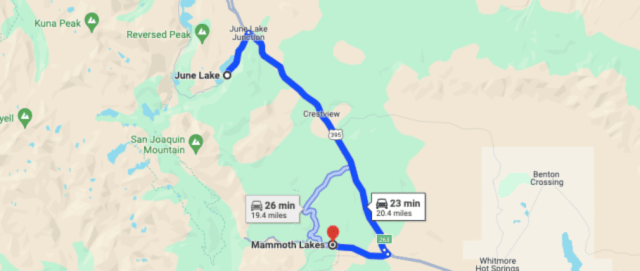
Mammoth Lakes is just half an hour from June Lake, and you could bypass a stop at June Lake and head straight here instead. There’s lots to do in Mammoth year-round. In summer, there’s hiking, rock climbing, kayaking or paddleboarding, swimming, and many more outdoor activities. In winter, there’s skiing at Mammoth Mountain, or snowshoeing, sledding, and other wintry fun. Be sure to take the 30-minute drive to Devil’s Postpile National Monument and see the odd basalt columns and Rainbow Falls. The monument is only open in summer, so check before you go.
Also, while staying in the Mammoth Lakes area, make the fifteen-minute drive to Convict Lake. Visitors and photographers marvel at the lake’s crystal clarity and you can hike the perimeter or fish in the lake.
Recommended RV campground: Twin Lakes Campground
Ancient Bristlecone Pine Forest
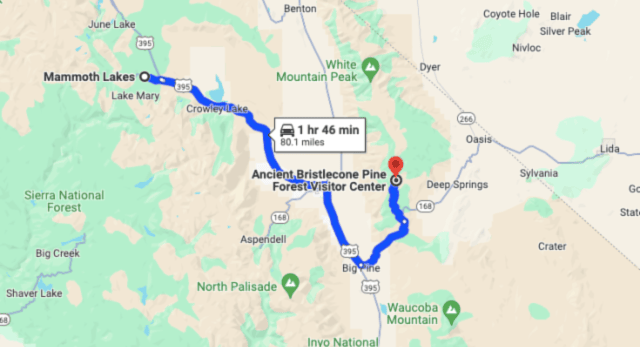
Your next stop after Mammoth Lakes is the Ancient Bristlecone Pine Forest, less than two hours away. This forest is home to some of the oldest trees in the world. Be sure to check out the Visitor Center, and Patriarch Grove. The Patriarch Tree is the world’s largest bristlecone pine.
You can make Bishop your home base, where you can restock and enjoy a treat from Erick Schat’s Bakery.
Recommended RV campground: Brown’s Town Campgrounds.
Mt. Whitney
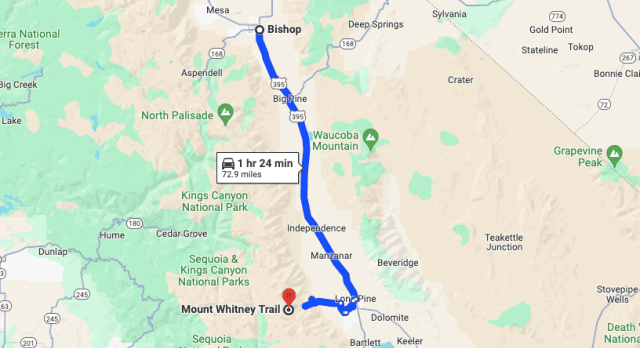
From Bishop, drive south and make time to stop in Keough’s Hot Springs. You’ll also go through the town of Independence, and you’ll want to stop at the Manzanar National Historic Site. This is the best-preserved internment camp where Japanese-Americans were held during World War II.
From there, you can proceed to the Mt. Whitney area. If you’re not planning on hiking the 14,505-foot-tall mountain, you can still drive up the Whitney Portal Road and see some beautiful scenery (and cool off if the desert is hot!). The road is only open in summer, and
Recommended RV campground: Whitney Portal Campground
Death Valley National Park
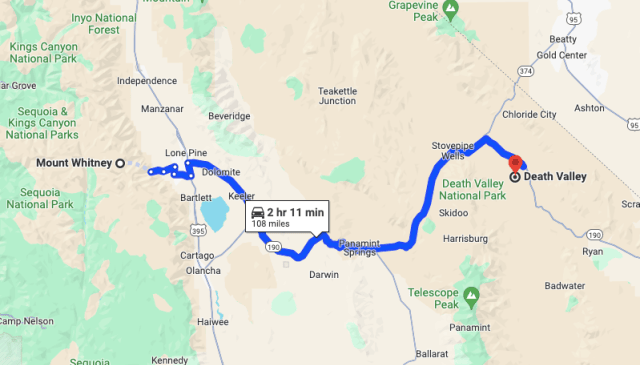
From Mt. Whitney, it’s less than a 2 1/2-hour drive to Death Valley National Park. You could spend several days exploring the park. Hike Mosaic Canyon, check out the amazing colors of nature at Artists Palette, and walk at the lowest point in North America – Badwater Basin. Death Valley has recorded some of the hottest temperatures in the world, so it’s a park best explored in late fall, winter, or early spring before the extreme heat sets in.
Recommended RV campground: Furnace Creek Campground
San Bernardino
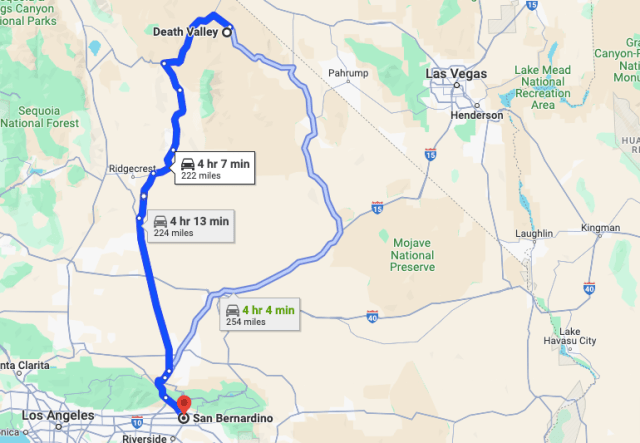
From Death Valley National Park, you’ll have just over a 4-hour drive to the start of Highway 395 near San Bernardino. There are lots of places to visit from here – you could head west and spend some time in Los Angeles and the nearby beaches. You could also head for Palm Springs, or tick off another national park by going to Joshua Tree National Park. You could also spend some time in the San Bernardino Mountains, at Lake Arrowhead or Big Bear.
I hope this guide to Highway 395 has been helpful! There are lots of options for amazing stops and sights to see along this highway. Whichever ones you choose to visit, you’re sure to have a memorable RV road trip.






